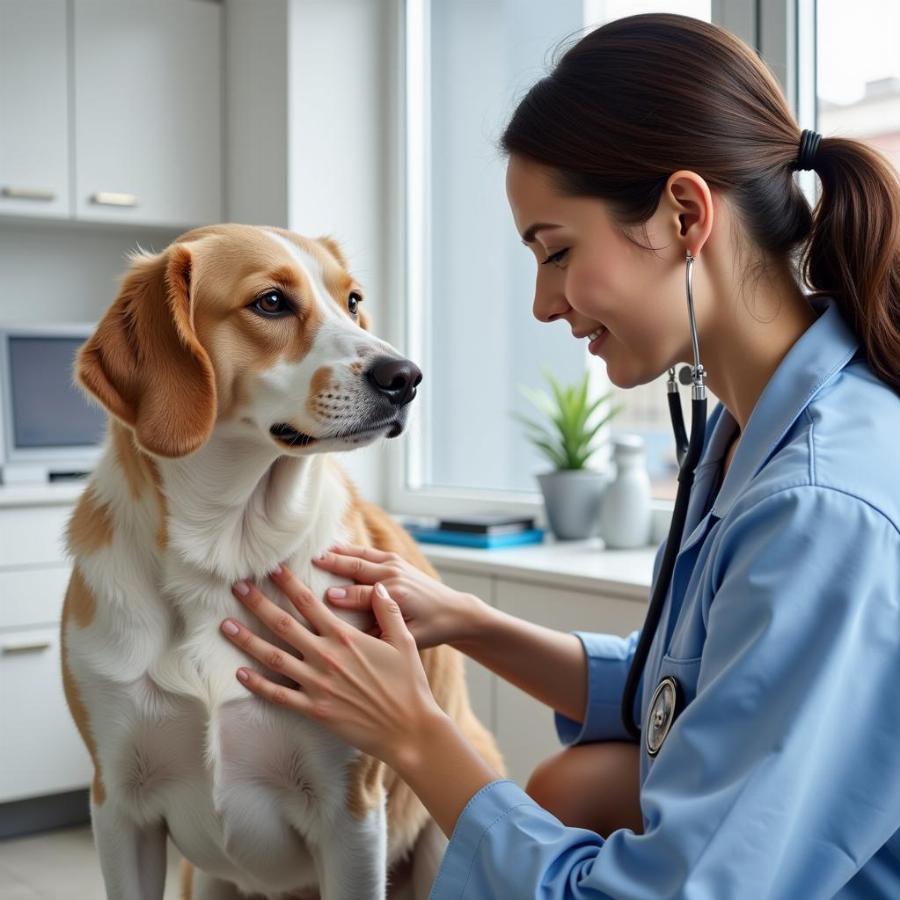Relaxation protocols for dogs are becoming increasingly popular as pet owners recognize the importance of managing stress and anxiety in their furry companions. Whether your dog suffers from separation anxiety, noise phobias, or general nervousness, understanding and implementing a relaxation protocol can significantly improve their quality of life. This guide will delve into the various aspects of relaxation protocols, providing you with the knowledge and tools to help your dog achieve a state of calm and well-being.
Understanding the Need for a Relaxation Protocol for Dogs
Just like humans, dogs experience stress and anxiety, which can manifest in various ways, including excessive barking, destructive behavior, panting, and pacing. These behaviors not only disrupt the household but also negatively impact the dog’s overall health and happiness. A relaxation protocol provides a structured approach to calming your dog, helping them cope with stressful situations and develop coping mechanisms.
Building a Relaxation Protocol for Your Dog
A successful relaxation protocol is tailored to the individual dog’s needs and triggers. It often involves a combination of techniques, including:
- Environmental Modifications: Creating a safe and predictable environment is crucial for anxious dogs. This can involve providing a designated “safe space,” minimizing exposure to triggers, and using calming pheromones.
- Behavior Modification: Techniques like counter-conditioning and desensitization can help dogs learn to associate positive experiences with previously stressful situations. relaxation protocol dog
- Sensory Enrichment: Providing opportunities for mental and physical stimulation can help reduce anxiety and boredom. This can include puzzle toys, interactive games, and regular exercise.
Implementing Relaxation Techniques
Several relaxation techniques can be incorporated into your dog’s protocol:
- Massage and Touch: Gentle massage can help relax muscles and reduce tension.
- Music Therapy: Calming music has been shown to have a positive effect on dogs, reducing anxiety and promoting relaxation. chill protocol for dogs
- TTouch: This specialized touch therapy technique can help calm the nervous system and reduce anxiety.
- Aromatherapy: Certain essential oils, like lavender and chamomile, can have a calming effect on dogs when used safely and appropriately. Always consult with a veterinarian before using essential oils around your dog.
Addressing Specific Anxiety Triggers
Different dogs have different triggers for anxiety. Identifying and addressing these triggers is essential for a successful relaxation protocol:
Separation Anxiety
- Gradual Desensitization: Gradually increase the duration of time your dog is left alone.
- Counter-Conditioning: Associate leaving with something positive, like a special treat or toy. dog relaxation protocol
- Create a “Safe Space”: Provide a comfortable and secure den-like area for your dog.
Noise Phobias
- Desensitization and Counter-Conditioning: Gradually expose your dog to the sounds they fear while pairing them with positive experiences.
- Sound Masking: Use white noise or calming music to muffle the sounds.
When to Seek Professional Help
While many dogs benefit from at-home relaxation protocols, some cases require professional intervention. If your dog’s anxiety is severe or impacting their quality of life, consult with a certified professional dog trainer or a veterinary behaviorist. ketamine for dogs They can assess your dog’s specific needs and develop a tailored behavior modification plan.  Veterinarian Examining Dog
Veterinarian Examining Dog
Conclusion
Implementing a relaxation protocol for your dog requires patience, consistency, and a deep understanding of your dog’s individual needs. By incorporating the techniques and strategies outlined in this guide, you can help your dog achieve a state of calm and well-being, improving their overall quality of life and strengthening your bond.
FAQ
-
How long does it take for a relaxation protocol to work? The timeframe varies depending on the dog and the severity of their anxiety. It can take weeks or even months to see significant improvement.
-
Can I use human relaxation techniques on my dog? Some human relaxation techniques, like massage, can be adapted for dogs. However, always consult with a professional before trying any new techniques.
-
Are there any medications that can help with dog anxiety? Yes, your veterinarian can prescribe medications to help manage anxiety in dogs.
-
Is it normal for my dog to be anxious sometimes? Yes, some level of anxiety is normal in dogs. However, excessive or persistent anxiety should be addressed.
-
What are the signs of stress in dogs? Signs of stress can include panting, pacing, excessive barking, destructive behavior, and changes in appetite.
-
Can puppies benefit from relaxation protocols? Yes, introducing relaxation techniques early in a puppy’s life can help them develop coping mechanisms for stress.
-
What if my dog’s anxiety gets worse despite implementing a relaxation protocol? Consult with a professional dog trainer or veterinary behaviorist for further guidance.
Beaut Dogs is your one-stop resource for all things related to dog care. We provide expert advice and guidance on a wide range of topics, from breed selection to health and nutrition. When you need support, contact us at Email: [email protected] for detailed and accurate answers. Beaut Dogs is committed to helping you provide the best possible care for your beloved canine companion.